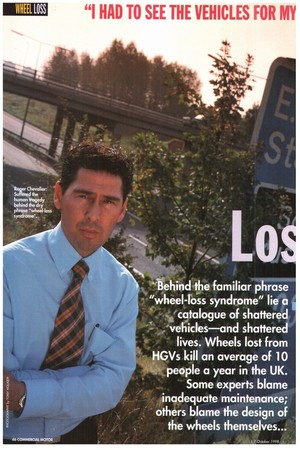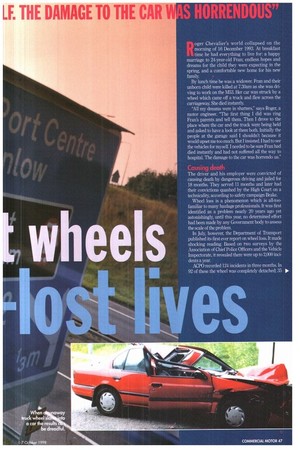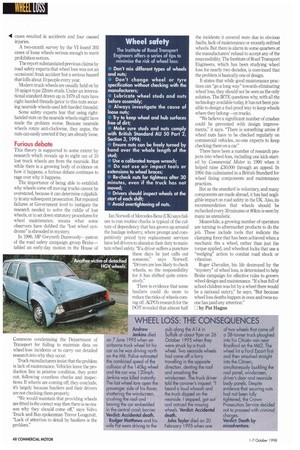WHEEL LOSS
Page 48

Page 49

Page 50

If you've noticed an error in this article please click here to report it so we can fix it.
'behind the familiar phrase "wheel-loss syndrome" lie a catalogue of shattered -'vehicles—and shattered lives. Wheels lost from QVs kill an average of 10 people a year in the UK.
Some experts blame inadequate maintenance; others blame the design of the wheels themselves...
oger Chevalier's world collapsed on the morning of 16 December 1993. At breakfast time he had everything to live for: a happy marriage to 24-year-old Fran; endless hopes and dreams for the child they were expecting in the spring, and a comfortable new home for his new family By lunch lime he was a widower. Fran and their unborn child were killed at 7.30am as she was driving to work on the M53. Her car was struck by a wheel which came off a truck and flew across the carriageway. She died instantly.
"All my dreams were in shatters," says Roger, a motor engineer. "The first thing I did was ring Fran's parents and tell them. Then I drove to the place where the car and the truck were being held and asked to have a look at them both. Initially the people at the garage said I shouldn't because it would upset me too much. But I insisted.! had to see the vehicles for myself.! needed to be sure Fran had died instantly and had not suffered all the way to hospital. The damage to the car was horrendo us."
The driver and his employer were convicted of causing death by dangerous driving and jailed for 18 months. They served 11 months and later had their convictions quashed by the High Court on a technicality, according to safety campaign Brake.
Wheel loss is a phenomenon which is all-toofamiliar to many haulage professionals. It was first identified as a problem nearly 20 years ago yet astonishingly, until this year, no determined effort had been made by any Government body to assess the scale of the problem.
In July, however the Department of Transport published its first ever report on wheel loss. It made shocking reading. Based on two surveys by the Association of Chief Police Officers and the Vehicle Inspectorate, it revealed there were up to 2,000 incidents a year.
ACPO recorded 124 incidents in three months. In 92 of these the wheel was completely detached; 35 cases resulted in accidents and four caused injuries.
A two-month survey by the VI found 303 cases of loose wheels serious enough to merit prohibition notices.
The report substantiated previous claims by road safety experts that wheel loss was not an occasional freak accident but a serious hazard that kills about 10 people every year.
Modern truck wheels are usually held on by 10 spigot-type 22mm studs. Under an international standard drawn up in 1979 all nuts have right-handed threads (prior to this nuts securing nearside wheels used left-handed threads).
Some safety experts fear that using righthanded nuts on the nearside wheels might have made the problem worse. Because nearside wheels rotate anti-clockwise, they argue, the nuts can easily unwind if they are already loose.
Furious debate
This theory is supported to some extent by research which reveals up to eight out of 10 lost truck wheels are from the nearside. But while there is a growing body of evidence on how it happens, a furious debate continues to rage over why it happens, The importance of being able to establish why wheels come off moving trucks cannot be overstated, because it can determine culpability in any subsequent prosecution. But repeated failures at Government level to instigate the research needed to solve the riddle of lost wheels, or to set down statutory procedures for wheel maintenance, means what some observers have dubbed the "lost wheel syndrome is shrouded in mystery.
In 1996, MP Gwyneth Dunwoody—patron of the road safety campaign group Brake— tabled an early-day motion in the House of Commons condemning the Department of Transport for failing to maintain data on wheel-loss incidents or to carry out detailed research into why they occur.
Truck manufacturers insist that the problem is lack of maintenance. Vehicles leave the production line in pristine condition, they point out, following countless checks and inspections. If wheels are coming off, they conclude, it's largely because hauliers and their drivers are not checking them properly.
"We would maintain that providing wheels are fitted in the correct way then there is no reason why they should come off," says Volvo Truck and Bus spokesman Trevor Longcroft. "Lack of attention to detail by hauliers is the problem."
Ian Norwell of Mercedes-Benz (UK) says failure to run routine checks is typical of the culture of dependency that has grown up around the haulage industry, where prompt and competitively priced tyre replacement services have led drivers to abandon their duty to maintain wheel safety. "If a driver suffers a puncture these days he just calls out someone," says Norwell. "Drivers are less likely to check wheels, so the responsibility for it has shifted quite extensively."
HGV wheels.
There is evidence that some hauliers could do more to reduce the risks of wheels coming off. ACPO's research for the DOT revealed that almost half the incidents it covered were due to obvious faults, lack of maintenance or recently refitted wheels. But there is alarm in some quarters at the manufacturers' refusal to accept any of the responsibility. The Institute of Road Transport Engineers, which has been studying wheel loss for nearly two decades, is convinced that the problem is basically one of design.
It states that while good maintenance practices can "go a long way" towards eliminating wheel loss, they should not be seen as the only solution. The IRTE questions why, with all the technology available today, it has not been possible to design a fool-proof way to keep wheels where they belong—on trucks.
"We believe a significant number of crashes could be prevented with design improvements," it says. "There is something amiss if wheel nuts have to be checked regularly on commercial vehicles...no-one expects to keep checking them on a car."
There have been a number of research projects into wheel-loss, including one kick-started by Commercial Motor in 1990 when it helped raise £30,000 through an appeal. In 1994 this culminated in a British Standard for wheel fixing components and maintenance practices.
But as the standard is voluntary, and many components are made abroad, it has had negligible impact on road safety in the UK. Also, its recommendation that wheels should be rechecked every 30 minutes or 80km is seen by many as unrealistic.
Meanwhile, a growing number of operators are turning to aftermarket products to do the job. These include tools that indicate the clamping force that has been achieved when a mechanic fits a wheel, rather than just the torque applied, and wheelnut locks that use a "wedging" action to combat road shock or vibration.
Roger Chevalier, his life destroyed by the "mystery" of wheel loss, is determined to help Brake campaign for effective rules to govern wheel design and maintenance. "If a bus full of school children was hit by a wheel there would be a national outcry," he says. "But because wheel loss deaths happen in ones and twos noone has paid any attention."
El by Pat Hagan
WHEEL LOSS: THE CONSEQUENCES
„.,j Andrew ' Jenkins died on 7 June 1995 when an airborne truck wheel hit his car as he was driving north on the M6. Police estimated the combined speed of the collision of the 140kg wheel and the car was 120mph. Jenkins was killed instantly. The last wheel tore open the passenger side of his Rover, shattering the windscreen, crushing the roof and leaving the car embedded in the central crash barrier. Verdict: Accidental death.
Rodger Matthews and his wife Pat were driving to the pub along the Al 4 in Suffolk at about 9pm on 26 October 1995 when they were struck by a truck wheel. Two nearside wheels had come off a lorry travelling in the opposite direction, denting the roof and smashing the windscreen. The truck driver told the coroner's inquest: "I heard a loud whoosh and the truck dipped on the nearside. I stopped, got out and noticed the missing wheels Verdict: Accidental death.
John Taylor died on 20 February 1995 when one of two wheels that came off a 38-tanner truck ploughed into his Citroen van near Bradford on the M62. The wheel hit a Ford Escort first and then smashed straight into the Citroen, simultaneously buckling the roof panel, windscreen, driver's door and nearside body panels. Despite evidence that securing nuts had not been fully tightened, the Crown Prosecution Service decided not to proceed with criminal charges.
Verdict: Death by misadventure.
Wheel safety
The Institute of Road Transport Engineers offers a series of tips to minimise the risk of wheel loss: Don't mix different types of wheels and nuts; Don't change wheel or tyre specification without checking with the manufacturers; Lubricate wheel studs and nuts before assembly; Always investigate the cause of loose nuts; Try to keep wheel and hub surfaces free of dirt; Make sure studs and nuts comply with British Standard AU 50 Part 2, Section 3, 1994; Ensure nuts can be freely turned by hand over the whole length of the stud; Use a calibrated torque wrench; Do not use air impact tools or extensions to wheel braces; Re-check nuts for tightness after 30 minutes, even if the truck has not moved; Drivers should inspect wheels at the start of each shift; Avoid overtightening of nuts.
















































































































